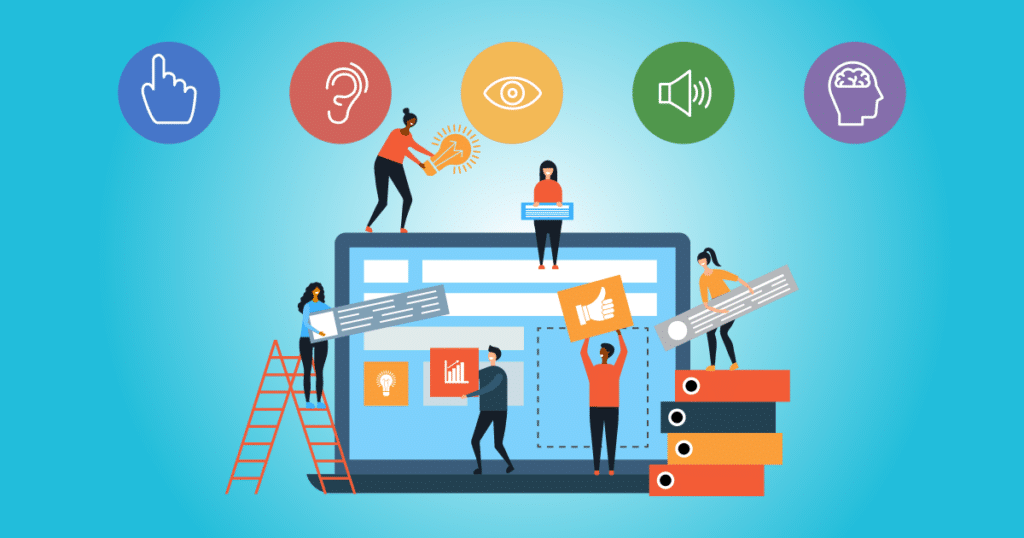Web accessibility and inclusive design have a lot in common. They both focus on making products easier to use for people with situational or permanent disabilities.
This can be as simple as adding descriptive alt text to images, ensuring that media content doesn’t flash more than three times per second (for epilepsy sufferers), or using clear and straightforward language without jargon.
Accessibility is a Human Right
Just as campus buildings and other physical locations have braille signs, wheelchair ramps, and elevators to accommodate those with disabilities, web content and online course materials should be accessible to all. After all, the Internet is a powerful tool that breaks down barriers of geography, language, culture, and ability.
Websites that aren’t designed with accessibility in mind can cause frustration and even isolation for users with disabilities. They might not be able to easily navigate the site, resulting in poor user experience and potentially causing them to leave your business or school.
Aside from a moral imperative, there are also numerous international accessibility regulations that prevent discrimination against people with disabilities and mandate website compliance. Some, like the Americans with Disabilities Act and the Accessibility for Ontarians with Disabilities Act, even include provisions that apply to public sector websites. Breaking these laws could result in hefty fines and lawsuits for schools, businesses, and organizations.
It’s a Legal Duty
There are currently no laws requiring businesses and government agencies to make their websites accessible to people with disabilities, but there are several existing technical standards that can help. These include Web Content Accessibility Guidelines (WCAG) and Section 508 standards, which the federal government uses for its own website.
These guidelines provide recommendations for making digital products more usable by users with permanent or temporary impairments, such as visual, hearing, speech and cognitive impairments or situational limitations like a broken leg or photosensitivity. Making your website accessible to people with these impairments is also a good business practice and shows that you care about all your customers.
In addition, if your business or government entity receives federal funds, you may be required to comply with the Americans with Disabilities Act (ADA). This law prohibits discrimination based on disability and requires that places of public accommodation like your website and mobile apps offer equal access to people with disabilities.
It’s a Competitive Advantage
With 1 billion people in the world living with disabilities (visual, hearing, motor, cognitive, learning and speech) a website that is not accessible is missing out on potential customers. By making your site accessible you can reach this audience and give them a better online experience that most of your competitors do not offer.
Incorporating accessibility into your design process right from the beginning of a project will also cut down on costs for later fixes and repairs. Not to mention, search engines favor sites that are accessible and will rank them higher in results pages – a sure way to get more organic traffic day after day.
Finally, a business that prioritizes web accessibility is able to promote themselves as a company that cares about the community and society at large. In a world of negative press and public relations, being proactive about this issue gives your brand a positive image that will resonate with all your guests.
It’s a Marketing Strategy
If you were building a physical storefront, wouldn’t you want to make sure that everyone could access it? In the same way, a digital site or application that is inaccessible excludes people with disabilities from using it.
Making your content accessible is also a smart marketing strategy. Websites that meet accessibility standards are rewarded with higher search engine rankings, and users who find the information they need quickly are more likely to return.
A popular myth is that accessibility is only for people with lifelong or severe disabilities, but this couldn’t be further from the truth. Even people with temporary or situational disabilities can benefit from the accessibility features that make your site easier to navigate and understand. This includes features like captions on videos, descriptive alt text for images, and an appropriate contrast ratio. All of these techniques can be implemented easily and with minimal cost. This is why it’s so important to incorporate accessibility in your web and mobile app development process.

